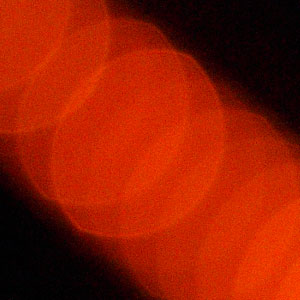The “cat’s eye” effect
Vignetting is in large part mechanical at wider apertures; the lens barrel itself cuts off part of the view, which of course means that effective diaphragm size is smaller off-center. A smaller diaphragm means an effectively smaller aperture, which can also cause an apparent sharpness increase off-center due to depth of field, all other optical factors being equal. Look for this effect, and you’ll see it with a variety of lenses.
Often noticed when shooting a lens wide open at night or dusk is the “cat’s eye” effect, where off-center areas take on an ovalized shape. You can see this effect directly by looking through any lens whose diaphragm will remain open when off the camera.
Shown below are center and corner crops. At center, the out-of-focus blurs are nicely rounded circles. In the corners, the shapes are ovalized. It takes 1-2 stops to produce rounded shapes in the corners, eg f/2.8 - f/4 for an f/2 lens.


Canon 5D Mark II + Zeiss ZE 28mm f/2 Distagon @ f/2

























